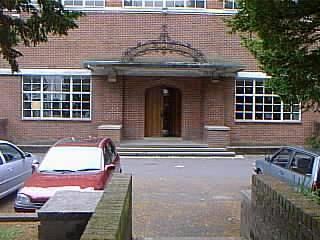Established 1682 Ages 11–18 Founded 1682 | Headmaster Mr. Ryan Davies Phone +44 1792 411400 Gender Mixed-sex education | |
 | ||
Location De La Beche RoadSwanseaSA2 9APUnited Kingdom Houses Rotherslade, Langland, Caswell, Limeslade, Bracelet Colours Years 7–11 Maroon and Gold Years 12–13 Navy Motto Virtue and good literature Similar Olchfa Compreh School, Gowerton School, Bishop Vaughan Catholic, Morriston Compreh School, Penyrheol Compreh School Profiles | ||
The Bishop Gore School (Welsh: Ysgol Esgob Gore) is a secondary school in Swansea in Wales, founded on 14 September 1682 by Hugh Gore (1613–1691), Bishop of Waterford and Lismore. It is situated in Sketty, close to Singleton Park and Swansea University. In December 2013 the school was ranked in the second highest of five bands by the Welsh Government, based on performance in exams, value added performance, disadvantaged pupils' performance, and attendance.
Contents
Grammar school
Established as a Free Grammar School, initially in Goat Street (a site now part of Princess Way in the city centre), for "the gratuitous instruction of twenty boys, sons of the most indigent burgesses, and in the event of a dissolution of the corporation, to sons of the poorest inhabitants of the town", it has since known several names and locations. In September 1853 the school moved, as the boys-only Swansea Grammar School, to Mount Pleasant into a new building designed by the architect Thomas Taylor. The building was extended in 1869 to a design by Benjamin Bucknall. The building was largely gutted by incendiary bombs during World War II although some of the 1869 building remains as part of the Swansea campus of the University of Wales Trinity Saint David.
After the war the school was moved to the Sketty area of Swansea where it subsequently became Bishop Gore Grammar school and briefly Bishop Gore Comprehensive School. It has been on its current Sketty site since 1952 with a large extension built in the 1970s and further Design and Technology extensions in the 1990s.
Comprehensive
Until 1970, Bishop Gore was an all-boys grammar school, then it merged with the girls' grammar school Glanmôr and Townhill Secondary School to become Bishop Gore Co-educational Comprehensive school in 1971.
School today
Currently Bishop Gore has around 1800 male and female students aged 11–18. The school has a sixth form with separate lounge, facilities and uniform. The headteacher is Ryan Davies (appointed September 2007). Set at the head of Singleton Park, close to the village of Sketty and the seafront, Bishop Gore is built around two quadrangles the red brick building has in the centre the second largest hall in Swansea, second only to the Brangwyn Hall. Each pupil is assigned to a house: Caswell, Langland, Bracelet, Rotherslade or Limeslade (named after beaches on the nearby Gower peninsular), which they retain throughout their time at the school. Highlights of the school year include the Eisteddfod, the inter-house sports tournaments, the productions by Bishop Gore Theatre Company, and the end-of-year balls for the senior students.
In January 2010, an inspection report was published which awarded Bishop Gore the highest possible grades in all categories. As a result of this the school was featured as a 'best practice' case study by Estyn and was named in the chief inspector's annual report – being the only secondary school in Wales to achieve this recognition.
With 88% of pupils in 2015 leaving the school with five GCSE grades A* – C, Bishop Gore is now second only to Bishopston Comprehensive School in terms of this statistic.
Dylan Thomas
The most famous alumnus of Bishop Gore is almost certainly the poet, playwright and author Dylan Thomas (1914–1953). His father, David John (D. J.) Thomas was senior English master at the school, then known as Swansea Grammar School. Not a distinguished pupil, he nonetheless gained attention through publishing his first poem in 1926, "The Song Of The Mischievous Dog" and in 1928 winning the school's annual one-mile race. He left in 1931 to begin work at The South Wales Daily Post as a junior reporter.
Old Goreans
Notable Old Goreans have included:
International Rugby players
Several Old Goreans have played international rugby, for the Wales national rugby union team or the Wales women's national rugby union team
